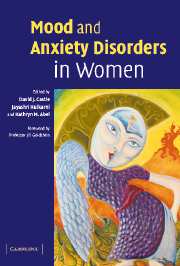Book contents
- Frontmatter
- Contents
- Contributors
- Preface
- Foreword
- 1 Pubertal development and the emergence of the gender gap in mood disorders: A developmental and evolutionary synthesis
- 2 Borderline personality disorder: Sex differences
- 3 Substance use and abuse in women
- 4 Anxiety disorders in women
- 5 Posttraumatic stress disorder in women
- 6 Domestic violence and its impact on mood disorder in women: Implications for mental health workers
- 7 Depression in women: Hormonal influences
- 8 Anxiety and mood disorders in pregnancy and the postpartum period
- 9 Pharmacological treatment of anxiety and depression in pregnancy and lactation
- 10 Bipolar affective disorder: Special issues for women
- 11 Mood and menopause
- 12 Anxiety and depression in women in old age
- Index
10 - Bipolar affective disorder: Special issues for women
Published online by Cambridge University Press: 13 August 2009
- Frontmatter
- Contents
- Contributors
- Preface
- Foreword
- 1 Pubertal development and the emergence of the gender gap in mood disorders: A developmental and evolutionary synthesis
- 2 Borderline personality disorder: Sex differences
- 3 Substance use and abuse in women
- 4 Anxiety disorders in women
- 5 Posttraumatic stress disorder in women
- 6 Domestic violence and its impact on mood disorder in women: Implications for mental health workers
- 7 Depression in women: Hormonal influences
- 8 Anxiety and mood disorders in pregnancy and the postpartum period
- 9 Pharmacological treatment of anxiety and depression in pregnancy and lactation
- 10 Bipolar affective disorder: Special issues for women
- 11 Mood and menopause
- 12 Anxiety and depression in women in old age
- Index
Summary
“Oddly enough, it had never occurred to me not to have children simply because I had manic-depressive illness … Of course, I had had serious concerns: How could one not? Would I, for example, be able to take care of my children properly? What would happen to them if I got severely depressed? Much more frightening still, what would happen to them if I got manic, if my judgment became impaired, if I became violent or uncontrollable? How would it be to watch my own children struggle with depression, hopelessness, despair, or insanity if they themselves became ill? Would I watch them too hawkishly for symptoms or mistake their normal reactions to life as signs of illness?”
Kay Redfield Jamison, An Unquiet Mind (1995, p. 191–192)This poignant quote depicts the difficult and painful struggle that women with bipolar disorder (BD) face when contemplating motherhood. Generally a life-long condition beginning in late adolescence and early adulthood, most women with BD will experience this illness during their child-bearing years (Viguera et al., 2002a). For treating physicians, the event of pregnancy in a women with BD creates a challenging clinical dilemma. Essential to successful treatment is an understanding of the two ways this condition is manifested during childbearing. Firstly, women with a known history of BD are particularly vulnerable during pregnancy and the postpartum. The second manifestation of this condition is that of new onset BD in the postpartum; the adverse effects of puerperal psychosis are well documented.
Keywords
- Type
- Chapter
- Information
- Mood and Anxiety Disorders in Women , pp. 185 - 211Publisher: Cambridge University PressPrint publication year: 2006

